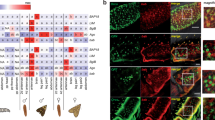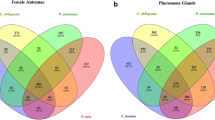Abstract
Crossing experiments between two closely related moths, Ostrinia scapulalis and O. zealis, were conducted to gain insight into the genetic basis of the divergence of female sex pheromones. The sex pheromone of O. scapulalis comprises (E)-11- and (Z)-11-tetradecenyl acetates (E11 and Z11), and distinct genetic variation is found in the blend of components. This variation is largely controlled by a single autosomal locus with two alleles, AE(sca) and AZ(sca). E-type (AE(sca)AE(sca)) females produce a pheromone with amean E11:Z11 ratio of 99:1, whereas Z-type (AZ(sca)AZ(sca)) and I-type (AE(sca)AZ(sca)) females produce a pheromone with a mean of 3:97 and 64:36, respectively. O. zealis is distinctive in that it has a third pheromone component, (Z)-9-tetradecenyl acetate (Z9), in addition to E11 and Z11, and the typical blend ratio is 60:35:5 (Z9:E11:Z11). Our study revealed that Z9 production in O. zealis is mainly regulated by an autosomal recessive gene phr(zea), which is suggested to be involved in the chain-shortening of a pheromone precursor fatty acid, and linked to AE(zea), a gene corresponding to AE(sca) in O. scapulalis. A few mutations in a gene involved in pheromone production could explain the dramatic shift between a two-component pheromone communication system in O. scapulalis and a three-component system in O. zealis.



Similar content being viewed by others
References
C. R. B. Boake (1991) ArticleTitleCoevolution of senders and receivers of sexual signals: Genetic coupling and genetic correlations Trends Ecol. Evol. 6 225–227
R. K. Butlin M. G. Ritchie (1989) ArticleTitleGenetic coupling in mate recognition systems: What is the evidence? Biol. J. Linn. Soc. 37 237–246
R. K. Butlin C. Trickett (1997) Can population genetic simulations help to interpret pheromone evolution? R. T. Cardé A. K. Minks (Eds) Insect Pheromone Research Chapman and Hall New York 548–562
R. T. CardÉ T. C. Baker (1984) Sexual communication with pheromones W. J. Bell R. T. Cardé (Eds) Chemical Ecology of Insects Chapman and Hall New York 355–383
D. S. Falconer (1989) Introduction to Quantitative Genetics Longman London
S. P. Foster S. J. Muggleston C. LÖfstedt B. Hansson (1997) A genetic study on pheromonal communication in two Ctenopseustis moths R. T. Cardé A. K. Minks (Eds) Insect Pheromone Research Chapman and Hall New York 514–524
A. N. Frolov (1998) ArticleTitleVariation in the European corn borer, Ostrinia nubilalis, and allies (Lepidoptera, Pyralidae) Mem. Soc. R. Berge. Entomol. 38 71–105
X. Fu J. Tabata Y. Huang T. Takanashi S. Ohno H. Honda S. Tatsuki Y. Ishikawa (2004) ArticleTitleFemale sex pheromone of Ostrinia orientalis—Throwing a light on the relationship between O. orientalis and the European corn borer, O. nubilalis Chemoecology 14 175–180
C. Gadenne J. F. Picimbon J. M. Becard B. Lalanne-Cassou M. Renou (1997) ArticleTitleDevelopment and pheromone communication systems in hybrids of Agrotis ipsilon and Agrotis segetum (Lepidoptera: Noctuidae) J. Chem. Ecol. 23 197–209
A. Hendrikse (1988) ArticleTitleHybridization and sex-pheromone responses among members of the Yponomeuta padellus-complex Entomol. Exp. Appl. 48 213–223
Y. Huang S. Tatsuki C. Kim S. Hoshizaki Y. Yoshiyasu H. Honda Y. Ishikawa (1997) ArticleTitleIdentification of sex pheromone of adzuki bean borer, Ostrinia scapulalis J. Chem. Ecol. 23 2791–2802
Y. Huang T. Takanashi S. Hoshizaki S. Tatsuki Y. Ishikawa (2002) ArticleTitleFemale sex pheromone polymorphism in adzuki bean borer, Ostrinia scapulalis, is similar to that in European corn borer, O. nubilalis J. Chem. Ecol. 28 533–539
Y. Ishikawa T. Takanashi C. Kim S. Hoshizaki S. Tatsuki Y. Huang (1999a) ArticleTitleOstrinia spp. in Japan: Their host plants and sex pheromones Entomol. Exp. Appl. 91 237–244
Y. Ishikawa T. Takanashi Y. Huang (1999b) ArticleTitleComparative studies on the sex pheromones of Ostrinia spp. in Japan: The burdock borer, Ostrinia zealis Chemoecology 9 25–32
R. A. Jurenka K. F. Haynes R. O. Adlof M. Bengtsson W. L. Roelofs (1994) ArticleTitleSex pheromone component ratio in the cabbage looper moth altered by a mutation affecting the fatty acid chain-shortening reaction in the pheromone biosynthetic pathway Insect. Biochem. Mol. Biol. 24 373–381
C. Kim S. Hoshizaki Y. Huang S. Tatsuki Y. Ishikawa (1999) ArticleTitleUsefulness of mitochondrial COII gene sequences in examining phylogenetic relationships in the Asian corn borer, Ostrinia furnacalis, and allied species (Lepidoptera: Pyralidae) Appl. Entomol. Zool. 34 405–412
C. E. Jr. Linn SuffixJr W. L. Roelofs (1995) Pheromone communication in moths and its role in the speciation process D. M. Lambert H. G. Spencer (Eds) Speciation and the Recognition Concept Johns Hopkins University Press Baltimore 263–300
P. W. K. Ma W. L. Roelofs (2002) ArticleTitleSex pheromone gland of the female European corn borer moth, Ostrinia nubilalis (Lepidoptera: pyralidae): Ultrastructural and biochemical evidences Zool. Sci. 19 501–511
L. Monti J. Genprmont C. Malosse B. Lalanne-Cassou (1997) ArticleTitleA genetic analysis of reproductive isolation between two closely related species, Spodoptera latifascia (Walker) and S. desconinsi (Lalanne-Cassou and Silvain) (Lepidoptera: Noctuidae) J. Evol. Biol. 10 121–134
A. Mutuura E. Munroe (1970) ArticleTitleTaxonomy and distribution of the European corn borer and allied species: Genus Ostrinia (Lepidoptera: Pyralidae) Mem. Entomol. Soc. Can. 71 1–112
S. Ohno (2003) ArticleTitleA new knotweed-boring species of the genus Ostrinia Hübner (Lepidoptera: Crambidae) from Japan Entomol. Sci. 6 77–83
P. L. Phelan (1997) Genetics and phylogenetics in the evolution of sex pheromones R. T. Cardé A. K. Minks (Eds) Insect Pheromone Research Chapman and Hall New York 563–579
W. L. Roelofs A. P. Rooney (2003) ArticleTitleMolecular genetics and evolution of pheromone biosynthesis in Lepidoptera Proc. Natl. Acad. Sci. U.S.A. 100 9179–9184
W. L. Roelofs T. J. Glover X. H. Tang I. Sreng P. Robbins C. Eckenrode C. LÖfstedt B. S. Hansson B. O. Bengtsson (1987) ArticleTitleSex pheromone production and perception in European corn borer moths is determined by both autosomal and sex-linked genes Proc. Natl. Acad. Sci. U.S.A. 84 7585–7589
W. L. Roelofs W. Liu G. Hao H. Jiao A. P. Rooney C. E. Jr. Linn SuffixJr. (2002) ArticleTitleEvolution of moth sex pheromone via ancestral genes Proc. Natl. Acad. Sci. U.S.A. 99 13621–13626
J. Tabata T. Takanashi Y. Ishikawa (2003) ArticleTitlePheromone analysis of wild female moths with a PBAN C-terminal peptide injection for an estimation of assortative mating in adzuki bean borer, Ostrinia scapulalis J. Chem. Ecol. 29 2749–2759
T. Takanashi Y. Huang R. Takahasi S. Hoshizaki S. Tatsuki Y. Ishikawa (2005) ArticleTitleGenetic analysis and population survey of sex pheromone variation in the adzuki bean borer moth, Ostrinia scapulalis Biol. J. Linn. Soc. 84 143–160
Y. Tazima (1964) The Genetics of the Silkworm Logos Press London
J. A. Tillman S. J. Seybold R. A. Jurenka G. J. Blomquist (1999) ArticleTitleInsect pheromone—An overview of biosynthesis and endocrine regulation Insect Biochem. Mol. Biol. 29 481–514
J. Zhu C. LÖfstedt B. O. Bengtsson (1996a) ArticleTitleGenetic variation in the strongly canalized sex pheromone communication system of the European corn borer, Ostrinia nubilalis Hübner (Lepidoptera; Pyralidae) Genetics 144 757–766
J. Zhu C. H. Zhao F. Lu B. O. Bengtsson C. LÖfstedt (1996b) ArticleTitleReductase specificity and the ratio regulation of E/Z isomers in pheromone biosynthesis of the European corn borer, Ostrinia nubilalis (Lepidoptera: Pyralidae) Insect Biochem. Mol. Biol. 26 171–176
Acknowledgments
We thank Drs. S. Tatsuki and S. Hoshizaki for advice. Insect samples from Dr. S. Ohno (O. zealis larvae on thistles) are acknowledged.
Author information
Authors and Affiliations
Corresponding author
Rights and permissions
About this article
Cite this article
Tabata, J., Ishikawa, Y. Genetic Basis to Divergence of Sex Pheromones in Two Closely Related Moths, Ostrinia scapulalis and O. zealis. J Chem Ecol 31, 1111–1124 (2005). https://doi.org/10.1007/s10886-005-4251-3
Received:
Accepted:
Published:
Issue Date:
DOI: https://doi.org/10.1007/s10886-005-4251-3




